Anions(Non-suppressor Method: NI-424 Column)
| Eluent (1) | Eluent (2) | |
|---|---|---|
| Main component | 4-Hydroxybenzoic acid | Phthalic acid |
| pH adjustment | Bis-Tris * | Amino caproic acid |
| Separation adjustment | Phenylboronic acid (Separation of phosphoric acid ion and fluoride ion promoted.) | Phenylboronic acid (Separation of phosphoric acid ion and fluoride ion promoted.) |
| Other | CyDTA** (Chelating agent to wash away trace amount of metal ion from system) | |
| Feature | Provides good peak balance, enabling measurement of even high concentration sample with good separation. | Improvement in quantitative determination of phosphoric acid ion, in particular, has been made. |
| Note | * Bis (2-hydroxyethyl) iminotris-(hydroxymethyl) methane | |
| ** trans-1,2-Diaminocyclohexane-N,N,N’,N’-tetraacetic acid | ||
| Adjustment of Eluent (1) | 1) Measure 1.105 g of 4-hydroxybenzoic acid, 0.586 g of Bis-Tris, 0.244 g of phenylboronic acid and 1.7 mg of CyDTA into a 1 liter measuring flask. Make it up to a 1 liter solution using ion exchange water. 2) After dissolving the mixture in the water by applying ultrasonic vibration, pass the solution through a 0.45 micron membrane filter and use the filtered solution as eluent. 3) For measuring low concentration ion in particular, purification of 4-hydroxybenzoic acid is recommended as impurities contained in the reagent need to be removed. Vacant peaks for trace amounts of the impurities in the reagent could interfere with the measurement. |
|
The time and the order for ion elution can be changed by altering the type, concentration and pH of eluent.
Effect of Eluent pH on Retention Time concerns eluent (1) and shows the effects of the pH of the eluent on the retention time of each ion. Adjust the eluent in accordance with the ion to be measured.
When alkaline eluent (more than pH 7) is used, it is necessary to prevent absorption of carbon dioxide into the eluent and resulting change in the pH of the eluent. Attach a carbon dioxide trap to the mouth of the bottle containing the eluent to prevent carbon dioxide from being absorbed into the eluent. Use of acidic eluent is normally recommended as it is stable.
The seven main anions can be separated using a newly developed column, IC NI-424 quickly. The theoretical plate number of the column is more than double that of the existing column IC I-524A.
Comparison with I-524A column:
1) NI-424 column has achieved separation of phosphoric acid ion and fluoride ion which was difficult to sepatate using I-524A.
2) With NI-424, each peak is sharper, and separation of ions and peak balance have been improved. In particular, improvement has been made in the separation of chloride and nitrite ions making NI-424 column suited to the analysis of a trace amount of nitrite ion contained in high-concentration chloride ion; demand for such analysis is high in the area of environmental analysis.
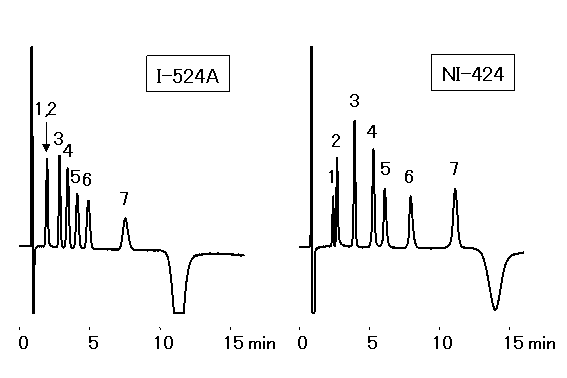
Sample : 20micro-L
1. H2PO4– 10mg/L
2. F– 1mg/L
3. Cl– 1mg/L
4. NO2– 5mg/L
5. Br– 5mg/L
6. NO3– 5mg/L
7. SO42- 5mg/L
(Left) Column : Shodex IC I-524A (4.6mmID*100mm) Eluent : 2.5mM Phthalic acid + 2.3mM Tris(hydroxymethyl)aminomethane aq. Flow rate : 1.2mL/min Detector : Non-suppressed coductivity Column temp. : 40deg-C (Right) Column : Shodex IC NI-424 (4.6mmID*100mm) Eluent : 8mM 4-Hydroxybenzoic acid + 2.8mM Bis-Tris + 2mM Phenylboronic acid + 0.005mM *CyDTA aq. Flow rate : 1.0mL/min Detector : Non-suppressed coductivity Column temp. : 40deg-C
* CyDTA: trans-1,2-Diaminocyclohexane-N,N,N’,N’-tetraacetic acid
Seven kinds of anions can be separated using IC NI-424 with phthalic acid eluent. Peak height of anions with phthalic acid eluent were around twice higher than chromatogram with hydroxybenzoic acid eluent. On the other hand, anions with phthalic acid eluent were eluted earlier then these peaks from H2PO4– to NO3– were closer each other.
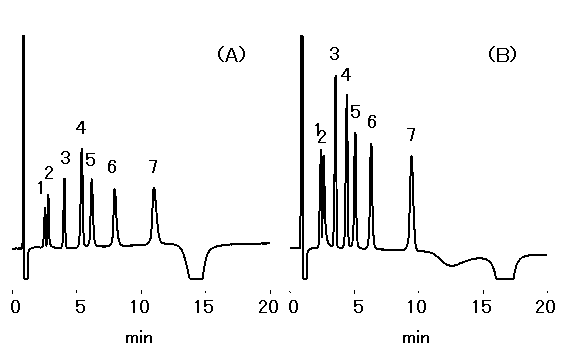
Sample : 100micro-L each
1. H2PO4– 10mg/L
2. F– 1mg/L
3. Cl– 1mg/L
4. NO2– 5mg/L
5. Br– 5mg/L
6. NO3– 5mg/L
7. SO42- 5mg/L
Column : Shodex IC NI-424 (4.6mmID*100mm) Eluent : (A) ; 8mM 4-Hydroxybenzoic acid + 2.8mM Bis-Tris + 2mM Phenylboronic acid + 0.005mM *CyDTA aq. (B) ; 2.1mM Phthalic acid + 2.9mM Amino-n-capronic acid + 6mM Phenylboronic acid aq. Flow rate : 1.0mL/min Detector : Non-suppressed coductivity Column temp. : 40deg-C
* CyDTA: trans-1,2-Diaminocyclohexane-N,N,N’,N’-tetraacetic acid
Four kinds of hydrophobic inorganic ions can be analyzed using IC NI-424.
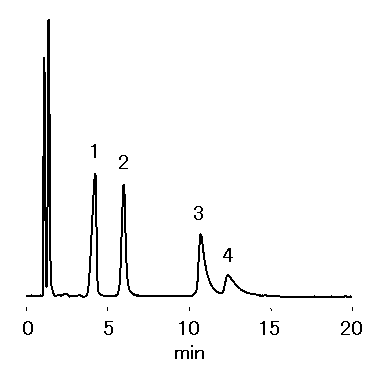
Sample : 20mg/L each, 50micro-L
1. S2O32-
2. I–
3. SCN–
4. ClO4–
Column : Shodex IC NI-424 (4.6mmID*100mm) Eluent : 0.9mM Sodium 1-octanesulufonate + 20mM Boric acid aq. Flow rate : 1.0mL/min Detector : Non-suppressed coductivity Column temp. : 40deg-C
Because of good separation of IC NI-424, nitrite ion can be separated and quantitatively determined even if the concentration of chloride ion is high.
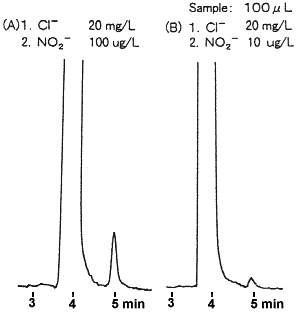
Sample : 100micro-L
1. Cl–
2. NO2–
Column : Shodex IC NI-424 (4.6mmID*100mm) Eluent : 8mM 4-Hydroxybenzoic acid + 2.8mM Bis-Tris + 2mM Phenylboronic acid + 0.005mM *CyDTA aq. Flow rate : 1.0mL/min Detector : Non-suppressed coductivity Column temp. : 40deg-C
* CyDTA: trans-1,2-Diaminocyclohexane-N,N,N’,N’-tetraacetic acid
| Regulations for water supply introduced on April, 2004 |
||
|---|---|---|
| Item | Criteria value | Usable method |
| Nitrate nitrogen & Nitrite nitrogen |
10mg/L or less
|
Ion chromatography
|
| Fluoride |
0.8mg/L or less
|
Ion chromatography |
| Chloride |
200mg/L or less
|
Ion chromatography or Titrimetric method |
The administrative order of the Ministry of Health, Labour and Welfare #261 (July 22, 2003) specifies the acceptable levels for F–, Cl–, NO2– and NO3–. Their concentrations are measured using ion chromatography. Here, anions in tap water were analyzed using IC NI-424 though NO2– could not be detected in tap water.
Please refer to ‘Regulation for Water Supply‘.
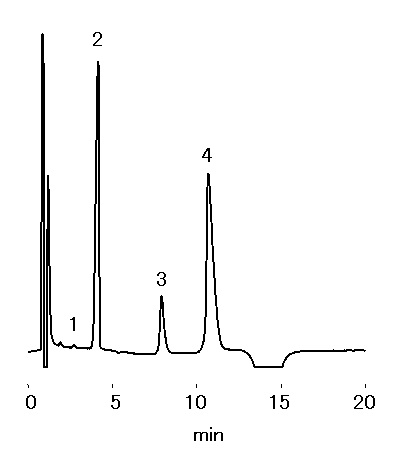
Sample : Tap water (Water), 100micro-L
1. F–
2. Cl–
3. NO3–
4. SO42-
Column : Shodex IC NI-424 (4.6mmID*100mm) Eluent : 8mM 4-Hydroxybenzoic acid + 2.8mM Bis-Tris + 2mM Phenylboronic acid + 0.005mM *CyDTA aq. Flow rate : 1.0mL/min Detector : Non-suppressed coductivity Column temp. : 40deg-C
* CyDTA: trans-1,2-Diaminocyclohexane-N,N,N’,N’-tetraacetic acid
Seven kinds of anions were detected using IC NI-424 in river water.
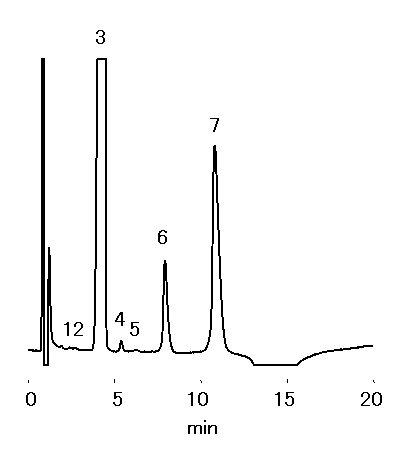
Sample : 5-fold diluted River water (Water), 10micro-L
1. H2PO4–
2. F–
3. Cl–
4. NO2–
5. Br–
6. NO3–
7. SO42-
Column : Shodex IC NI-424 (4.6mmID*100mm) Eluent : 8mM 4-Hydroxybenzoic acid + 2.8mM Bis-Tris + 2mM Phenylboronic acid + 0.005mM *CyDTA aq. Flow rate : 1.0mL/min Detector : Non-suppressed coductivity Column temp. : 40deg-C
* CyDTA: trans-1,2-Diaminocyclohexane-N,N,N’,N’-tetraacetic acid
Four kinds of anions in rain water were analyzed using IC NI-424.
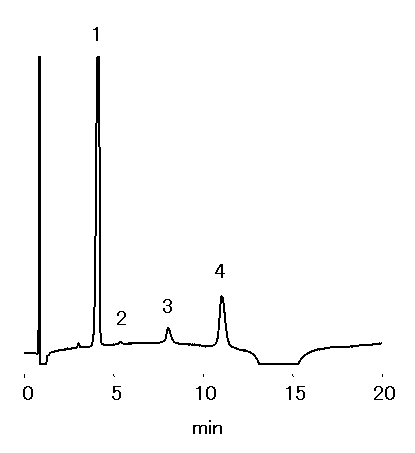
Sample : Rain water (Water), 100micro-L
1. Cl–
2. NO2–
3. NO3–
4. SO42-
Column : Shodex IC NI-424 (4.6mmID*100mm) Eluent : 8mM 4-Hydroxybenzoic acid + 2.8mM Bis-Tris + 2mM Phenylboronic acid + 0.005mM *CyDTA aq. Flow rate : 1.0mL/min Detector : Non-suppressed conductivity Column temp. : 40deg-C
* CyDTA: trans-1,2-Diaminocyclohexane-N,N,N’,N’-tetraacetic acid
When using IC NI-424 and the pH of the eluent is increased on the alkaline side, overall elution shortens. At a pH of 4.5 or higher, separation of F– and H2PO4– is difficult.

Sample : 30micro-L
1. H2PO4–
2. F–
3. Cl–
4. NO3–
5. SO42-
6. I–
7. SCN–
Column : Shodex IC NI-424 (4.6mmID*100mm) Eluent : 8mM 4-Hydroxybenzoic acid + 2mM Phenylboronic acid + 0.005mM CyDTA(pH adjusted with Bis-Tris) Flow rate : 1.0mL/min Detector : Non-suppressed conductivity Column temp. : 40deg-C
The column efficiency of IC NI-424 does not decline with an injection weight of up to 500 ng for chloride ion and of 5,000ng for sulphate ion. Concerning injection volume, an injection volume of up to 500micro-L does not cause any noticeable decline in the column efficiency at a concentration of 1 mg/L for both chloride and sulphate ions.
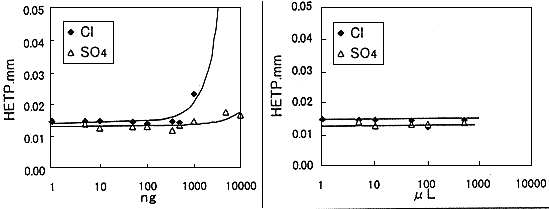
Column : Shodex IC NI-424 (4.6mmID*100mm) Eluent : 8mM 4-Hydroxybenzoic acid + 2.8mM Bis-Tris + 2mM Phenylboronic acid + 0.005mM *CyDTA(pH4.2) Flow rate : 1.0mL/min Detector : Non-suppressed conductivity Column temp. : 40deg-C
* CyDTA: trans-1,2-Diaminocyclohexane-N,N,N’,N’-tetraacetic acid
The figure shows calibration curves of IC NI-424for three kinds of anions. The calibration curves for chloride and nitrite ions exhibit linearity in a range between 0.01 and 100 mg/L. For phosphoric acid ion which has low sensitivity, the calibration curve exhibits linearity in a range between 0.1 and 100 mg/L.

Sample :
1. H2PO4–
2. Cl–
3. NO2–
Column : Shodex IC NI-424 (4.6mmID*100mm) Eluent : 2.1mM Phthalic acid + 2.9mM Amino-n-capronic acid + 6mM Phenylboronic acid aq. Flow rate : 1.0mL/min Detector : Non-suppressed conductivity Column temp. : 40deg-C
IC NI-424 permits measurement of fluoride ion on the order of micro-g/L in analyzing ultra pure water by the direct injection method specified in JIS(Japanese Industrial Standard) K 0556.

Sample : 1mL
F–
Column : Shodex IC NI-424 (4.6mmID*100mm) Eluent : 8mM 4-Hydroxybenzoic acid + 2.8mM Bis-Tris + 2mM Phenylboronic acid + 0.005mM *CyDTA aq. Flow rate : 1.0mL/min Detector : Non-suppressed conductivity Column temp. : 40deg-C
* CyDTA: trans-1,2-Diaminocyclohexane-N,N,N’,N’-tetraacetic acid
IC NI-424 has high theoretical plate number (more than 5,000). Carbonate and other anions can be separated well with NI-424.

Sample : 50micro-L
1. HCO3– 100mg/L
2. H2PO4– 10mg/L
3. F– 1mg/L
4. Cl– 1mg/L
5. NO2– 2mg/L
6. Br– 2mg/L
7. NO3– 2mg/L
8. SO42- 2mg/L
Column : Shodex IC NI-424 (4.6mmID*100mm) Eluent : 8mM 4-Hydroxybenzoic acid + 2.8mM Bis-Tris + 2mM Phenylboronic acid + 0.005mM *CyDTA Flow rate : 1.0mL/min Detector : Non-suppressed conductivity Column temp. : 40deg-C
* CyDTA: trans-1,2-Diaminocyclohexane-N,N,N’,N’-tetraacetic acid
1-Hydroxyethylidene-1,1-diphosphonate (HEDP), Nitrilotris(methylene phosphonate) (NTMP), N,N,N’,N’-Ethylenediaminetetrakis(methylene phosphonate) (EDTMP) and Diethylenetriaminepenta(methylene phosphonate) (DTPMP) were analyzed using IC NI-424.
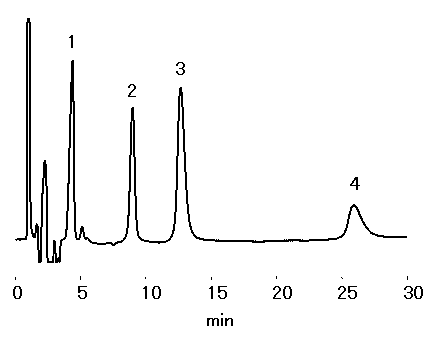
Sample : 100mg/L each, 100micro-L
1. 1-Hydroxyethylidene-1,1-diphosphonate, HEDP
2. Nitrilotris(methylene phosphonate), NTMP
3. N,N,N’,N’-Ethylenediaminetetrakis(methylene phosphonate), EDTMP
4. Diethylenetriaminepenta(methylene phosphonate), DTPMP
Column : Shodex IC NI-424 (4.6mmID*100mm) Eluent : 3mM H2SO4 aq. Flow rate : 1.0mL/min Detector : Shodex RI Column temp. : 40deg-C
To separate pyrophosphate(H2P2O72-) and tripolyphosphate (H3P3O102-) by ionexchange, an acidic eluent where they have a low ionic value is employed.
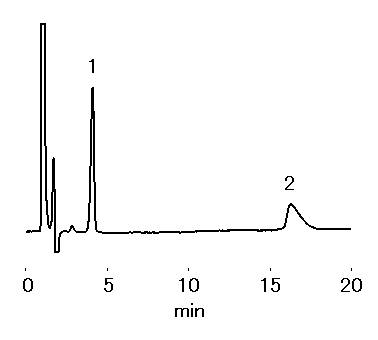
Sample : 150mg/L each, 100micro-L
1. H2P2O72-
2. H3P3O102-
Column : Shodex IC NI-424 (4.6mmID*100mm) Eluent : 8mM H2SO4 + 0.04mM EDTA・2Na aq. Flow rate : 1.0mL/min Detector : Shodex RI Column temp. : 40deg-C
IC NI-424 has high theoretical plate number (more than 5,000). Carbonate and other anions can be separated well with NI-424.
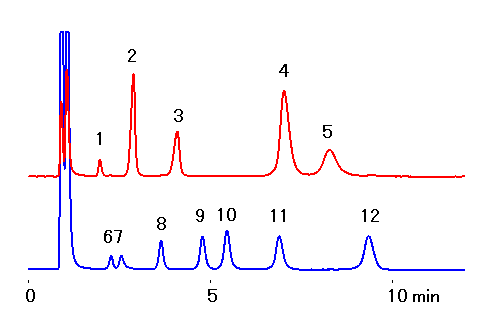
Sample : 20micro-L
1. Acetic acid 20.0mg/mL
2. Formic acid 20.0mg/mL
3. Malic acid 20.0mg/mL
4. Tartaric acid 20.0mg/mL
5. Oxalic acid 20.0mg/mL
6. H2PO4– 20.0mg/L
7. F– 1.5mg/L
8. Cl– 2.5mg/L
9. NO2– 6.0mg/L
10. Br– 10.0mg/L
11. NO3– 10.0mg/L
12. SO42- 10.0mg/L
Column : Shodex IC NI-424 (4.6mmID*100mm) Eluent : 8mM 4-Hydroxybenzoic acid + 2.8mM Bis-Tris + 2mM Phenylboronic acid + 0.005mM *CyDTA aq. Flow rate : 1.0mL/min Detector : Non-suppressed conductivity Column temp. : 40deg-C
* CyDTA: trans-1,2-Diaminocyclohexane-N,N,N’,N’-tetraacetic acid
